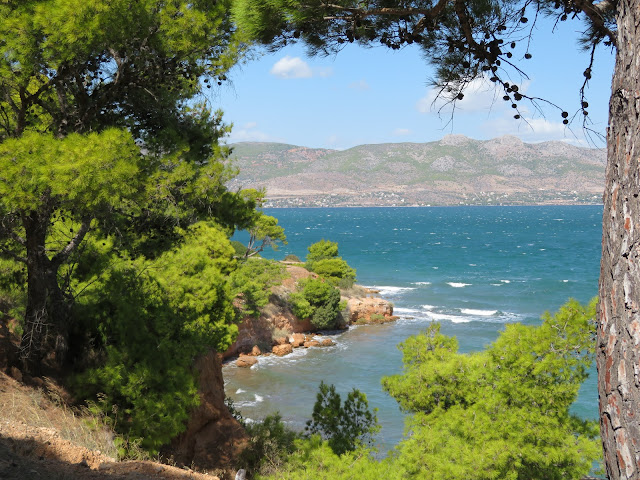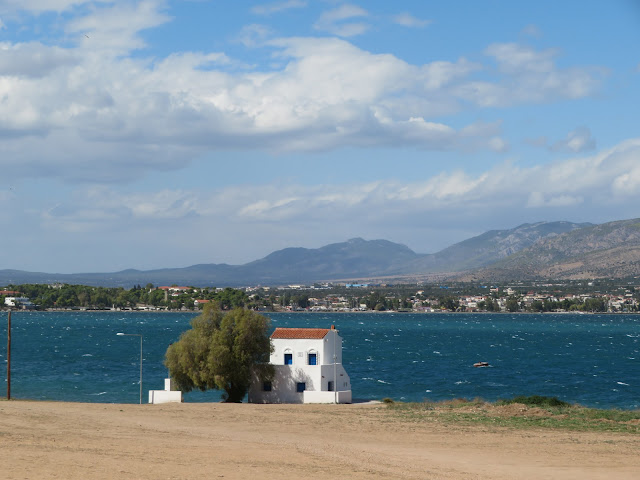Day 02. Glyfada - Loutraki
Day 02. Glyfada to Loutraki
Today the distance to pedal is 64.3 miles and 6,340 ft of elevation gain
Today's route is:
The Aegean Sea features prominently in many of the most famous Greek myths (Icarus and Daedelus, Theseus and the Minotaur, Jason and the Argonauts, The Odyssey, among others) and Plato made ample use of the islands in his dialogues.
Aegean Seaview is the name of The Hotel in Loutraki.
A myth tells where the Aegean sea got it's name from.
The story below was "borrowed" from:
http://greekerthanthegreeks.blogspot.com/2017/10/how-aegean-sea-of-greece-got-its-name.html
How the Aegean Sea of Greece Got its Name: A Wonderful but Sad Greek Myth
 |
| The Aegean Sea View from Mykonos Photo: Dimitris Tamposis |
If you look hard enough, there’s a story behind everything, especially when it relates to all things Greek.
The ancient Greeks were admirable story-tellers.
Take Aesop, who understood, that in order for children to remember lessons for life, you had to make those lessons interesting.
And that is exactly what Aesop did with his famed fables, using lovable animals, which became entangled in all sorts of predicaments, to acquaint children with the consequences of bad characteristics such as greed, insolence and deceit.
 |
| Aesop's Fables, The Tortoise and the Hare,. Arthur Rackham. |
The purpose of ancient Greek myths, as with Aesop’s fables, was to teach or to entertain, through, stories, passed down by word of mouth, before they were written, but most importantly, the ancient myths were a means of worship to their gods.
My knowledge of Greek Mythology comes from school, of course, and through reading, but mostly it comes from my children’s school homework (and I could write a whole blog post on that!).
One myth I remember well, and my daughter’s favourite, of which she reminded me just the other day, is the story of how The Aegean Sea, located between mainland Greece and Turkey, came by its name.
As with most stories passed down through word of mouth, people add bits here and forget bits there, resulting in copious variations on a theme.
Here is the wonderful tale of how the Aegean Sea got its name, the version which my daughter and I learnt together, many years ago.
Long, long ago, in the city of ancient Athens, there lived a king, Aegeus, who, after failing to produce a son and heir, with his first two wives, Meta and Chalciope, decided to consult the goddess Themis, one of the the oracles of Ancient Delphi, to see what he was doing wrong.
 |
| Themis, one of the oracles at ancient Delphi Illustration: H D Johnson |
The advice received from Themis was rather confusing to Aegeus:
"Do not loosen the bulging mouth of the wineskin until you have reached the height of Athens, lest you die of grief."
Pondering upon this conundrum, while on his way home to Athens, Aegeus dropped in on his old pal King Pittheus of Troezen (a small town in the northeastern Peloponnese).
”Pittheus is a wise old scoundrel" thought Aegeus, "he’ll work out the meaning of this riddle”.
Indeed Pittheus knew exactly what the cryptic prophecy from Themis was all about, and quickly proceeded to get Aegeus exceedingly drunk, and then, with a twinkle in his old eye, introduced Aegeus to his daughter, Aethra.
 |
| Aegeus consults with Themis, Oracle of Delphi. Circa 440–430 B.C. |
A Greek party, wine flowing plentifully, the king of Athens and a nubile young girl, the inevitable happened:
Aethra discovered she was pregnant!
Before the baby was born, Aegeus had to leave for Athens, where he was to marry his third wife, Medea.
Before he left, Aegeus placed his sandals and his sword under a rock, and instructed Aethra, that when the child came of age, he was to retrieve the sandals and the sword and return them to Aegeus in Athens.
Time passed, Aethra gave birth to a baby boy, who she named Theseus.
As instructed by Aegeus, on the boy’s coming of age, Aethra took him to the rock, presented him with the sandals and sword of Aegeus, and sent Theseus on his way to Athens.
 |
| Theseus and Aethra, Laurent de La Hyre |
Now, if you remember, Aegus had returned from Troezen to Athens, in order to marry Medea, which he did, and the marriage had produced a son, Medus.
Medea, who had her contacts on the grapevine, learnt that Theseus, son of Aegeus and Aethra, legitimate heir to the throne of Athens, was on his way to throw a spanner in her plans to have Medus, her son, crowned king.
 |
| Medea Evelyn De Morgan |
Medea put her devious mind in gear and reported to her husband, Aegeus, that local gossip had it; an impostor was on his way to Athens, about to declare himself to be Theseus, rightful heir to the throne of Athens.
“Never fear husband” Medea said to Aegeus, “’I know exactly how to foil this young whippersnapper, leave things to me”
Upon his arrival in Athens, Theseus found an invitation awaiting him; he was requested to attend a banquet at the palace of King Aegeus, as this was exactly where he was heading, Theseus happily accepted the invite.
Meanwhile, back at the palace, Medea informed Aegeus of her evil plan; they would poison Theseus and be rid of him once and for all.
 |
| Medea, Theseus and Aegeus, William Russell Flint (1910) |
Aegeus, a kind man at heart, wasn’t too keen on killing a fellow human without out knowing all the ins and outs of his crime, but on the other hand, could he bear the wrath of Medea if he didn’t play along with her dastardly doings?
Against his better judgment, Aegeus agreed to poison Theseus, but, at the banquet, just as Medea was handing a cup of poisoned wine to the impostor, he recognized his sandals and sword, this was no impostor, this was his true son, Theseus!
Aegeus embraced his son, and with no further ado, had Medea and her son, Medus, banished from the city of Athens, but what had Theseus unwittingly gotten himself into?
 |
| Theseus Recognized by his Father Hippolyte Flandrin (1832) |
These were not peaceful times in Athens, Aegeus, and his brother, Minos, king of Crete, were engaged in ongoing sibling rivalry, and, to add insult to injury, Androgeus, son of king Minos of Crete, continuously won all events in the Panathenaic Games.
This made Androgeus the golden boy of Athens, much to the disgust of the Pallantidai, the fifty sons of Pallas, nobles of Athens, rivals of their uncle Aegeus and his son Theseus over the Athenian throne, who, green with jealousy and red with embarrassment, assassinated Androgeus, which, as you would expect, did not go down too well with Minos, who immediately attacked Athens.
Minos of Crete demanded his son’s assassins be handed over to him, and Athens would be spared, but, as Aegeus did not know the identity of the assassins, this, he could not do.
After much argy bargy, confrontations and negotiations, Minos finally agreed to peace between Athens and Crete on one condition.
 |
| Gustave Doré's illustration of King Minos for Dante Alighieri's Inferno. |
The price Athens was to pay for peace with Crete, was that every nine years, Athens was to send seven male and seven female youths to Crete, who would then be sacrificed to the ferocious creature, with the head of a bull and body of a man, the Minotaur, which was imprisoned in a labyrinth (created by Daedalus of Icarus and Daedalus fame).
After the third time of shipping fourteen youths over to Crete, to be devoured by the dreadful Minotaur, Theseus had had enough, and decided to put an end to this barbaric carry on, he would go as one of the youths to be shipped out, and slay the Minotaur!
 |
| The Minotaur of Crete George Frederick Watts |
On hearing of Theseus’ heroic stand, Aegeus, understandably, feared for his son’s life.
To mollify his father’s fears, Theseus explained to him, that he would sail out with black sails, and, after slaying the Minotaur, to show that all was well, and that he was still alive, would make the return journey under white sails.
Theseus set sail for Crete, and, with his fears only slightly alleviated, Aegeus made for Cape Sounion, a good look out point, to wait anxiously for that first glimpse of, hopefully, white, homeward bound sails.
 |
Temple of Poseidon, (God of the Sea), at Cape Sounion
South of Athens, Greece.
Photo: National Geographic
|
On landing in Crete, Theseus met up with Ariadne, his cousin and daughter of king Minos, and, as in all great Greek myths, they fell in love.
To help Theseus with his daunting task, Ariadne gave him a ball of string, telling him to unravel it as he made his way through the labyrinth, and to follow it, after slaying the Minotaur, so as to find his way back.
 |
| Ariadne Giving Theseus a Ball of String to Find His Way Out of the Maze. Pelagio Palagi, 19th century |
All went to plan.
Theseus killed the beast, followed the string, made it back to Ariadne, and the two of them made a run for it, back to Athens,stopping off at the island of Naxos on the way, where a great celebration was held in their honour.
 |
| Theseus and the Minotaur in the Labyrinth. Edward Burne-Jones, 1861 |
Ariadne, not accustomed to flagons of Greek wine, fell asleep on the shore, and missed the boat to Athens (Some versions of the story have Theseus abandoning Ariadne purposely).
On discovering that Ariadne was not aboard the boat for Athens, Theseus, in his upset and panic, forgot to change the black sails for white ones.
 |
| Ariadne in Naxos Evelyn De Morgan (1877) |
Back in Sounion, Aegeus, beside himself with worry, was devastated to spot his son’s returning ship, carried along by the winds which were filling its black sails.
 |
| Illustration for the tales of two MusInt (Museo Interattivo) Panaiotis Kruklidis |
No, this could not be, the sails were meant to be white, and, in a rush of emotion, believing his son to be dead, Aegeus threw himself off the cliffs and perished in the sea below.















Comments
Post a Comment